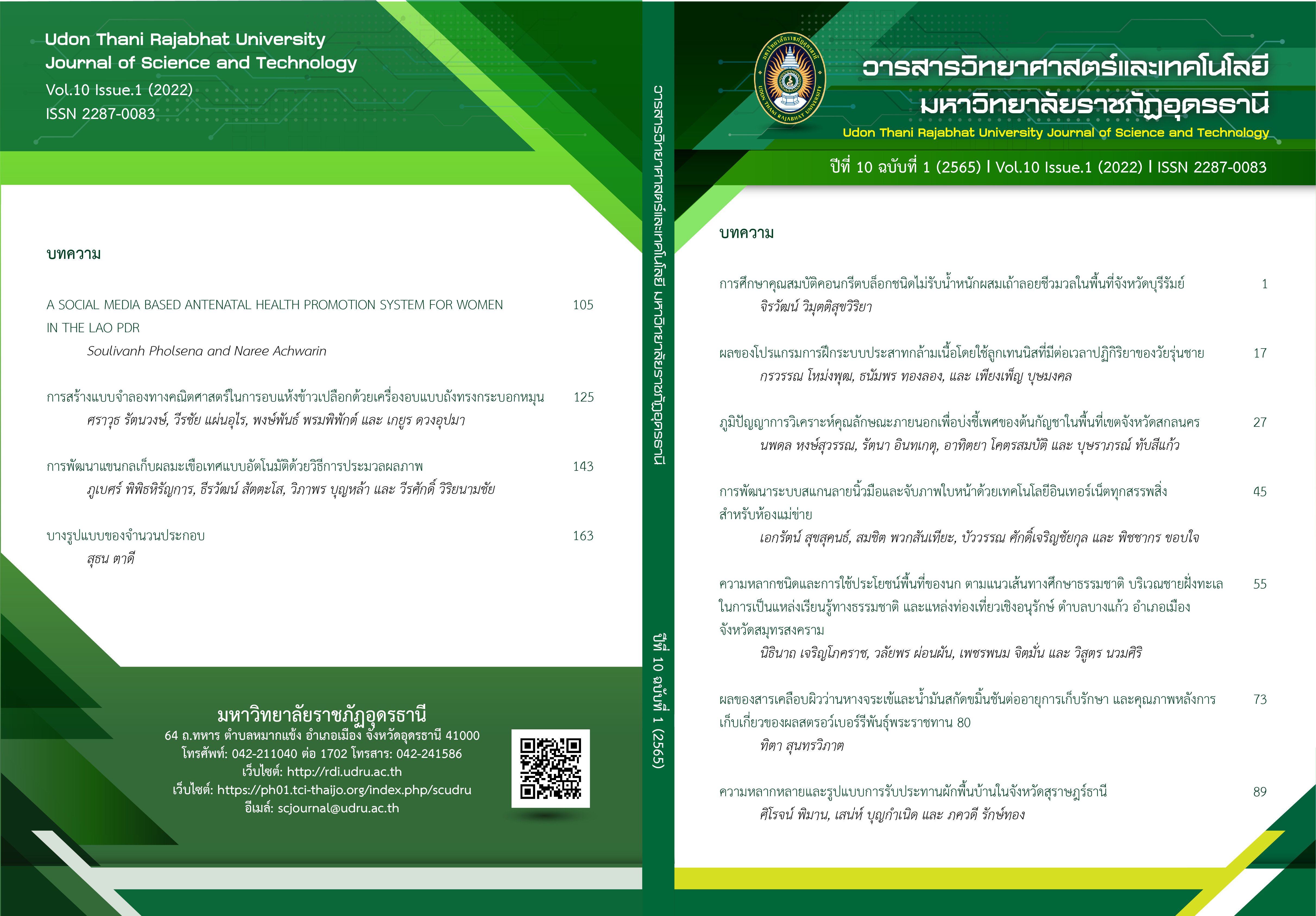EFFECT OF ALOE VERA AND TURMERIC ESSENTIAL OIL COATING ON STORAGE SHELF-LIFE AND POSTHARVEST QUALITY OF STRAWBERRY CV. NO.80
Main Article Content
Abstract
This study was on the effect of aloe vera and turmeric essential oil coating on the storage shelf-life and postharvest quality of strawberry cv. No.80 when stored at room temperature at 26±2 ºC with relative humidity at 60–75%. The research found that strawberry coating with 75% of aloe vera mixed with turmeric essential oil helped in slowing down the respiration rate and fresh weight loss and also declined the rate of ripening when compared with strawberry coating with 50% and 100% of aloe vera mixed with turmeric essential oil as well as strawberry without coating (P<0.05). According to the daily measurement of physical appearance and chemical composition in strawberries, it was found that aloe vera mixed with turmeric essential oil coating in any concentration not only enhanced the gloss and shine of strawberries but also reduced the incidence of wounds caused by abrasion on their surface. In addition, coating with aloe vera mixed with turmeric essential oil significantly decreased fresh weight loss, declined color change, texture change, as well as the amount of vitamin C (P<0.05). Therefore, the use of natural essence in strawberry coating may be an optional way to extend the storage and shelf-life for farmers in the future, including enabling farmers to produce harmless agricultural products for producers and consumers, as well as being environmentally friendly based on the principle that farmers would be able to access the local products.
Article Details
References
คงกฤช อินทแสน. (ม.ป.ป.). สตรอเบอรี่. ศูนย์ส่งเสริมการเกษตรที่สูง จังหวัดกาญจนบุรี. สืบค้นเมื่อวันที่ 21 กันยายน 2564, จาก https://esc.doae.go.th/wp-content/ uploads/2015/02/stawberry.pdf
ดนัย บุณยเกียรติ. (2540). สรีรวิทยาหลังการเก็บเกี่ยวพืชสวน. เชียงใหม่: คณะเกษตรศาสตร์ มหาวิทยาลัยเชียงใหม่.
ดนัย บุณยเกียรติ และ นิธิยา รัตนาปนนท์. (2535). การปฏิบัติการหลังการเก็บเกี่ยวผักและ ผลไม้. กรุงเทพฯ: สำนักพิมพ์โอเดียนสโตร์.
ธเนศวร์ สีระแก้ว, ชญาน์นันท์ โค้วอินทร์, นิสิต บุญเพ็ง และ จงรัก อิ่มใจ. (2556). เกษตรกร GAP ดีเด่น สาขาระบบการจัดการคุณภาพ GAP: พืช. วิจัยและพัฒนาการเกษตร สำนักวิจัยและพัฒนาการเกษตร เขตที่ 1 (สวพ.1), 14(1), 3-7.
Amarante, C., & Bank, N. H. (2001). Postharvest physiology and quality of coated fruits and vegetables. Horticultural Reviews, 26, 161- 238.
AOAC. (1984). Methods of Analysis (14th ed.). Washington, DC: Association of Official Analytical Chemists.
Baldwin, E. A. (1994). Edible coating for fresh fruits and vegetables: past present, and future. In: Krochta, J. M., Baldwin, E. A., & Nisperos, M.O. Carriedo (Eds.), Edible coatings and films to improve food quality (pp. 25-64). Lancaster, Basel: Technomic Publishing Inc.
Baldwin, E. A., Nisperos, M. O., Hagenmaier, R. H., & Baker, R. A. (1997). Use of lipids in edible coatings for food products. Food Technology, 51, 56-62.
Bautista-Banos, S., Hernandez-Lauzardo, A.N., Velazquez-del Valle, M.G., Hernandez-Lopez, M., Barka, E. A., Bosquez-Molina, E., & Wilson, C. (2006). Chitosan as a potential natural compound to control pre and postharvest diseases of horticulture commodities. Crop Protection, 25, 108-118.
Chien, P. J., Sheu, F., & Lin, H. R. (2007). Coating citrus (Murcott tangor) fruit with low molecular weight chitosan increase postharvest quality and shelf life. Food Chemistry, 100, 1120-1164.
Hamid, H. (2014). Effect of Aloe vera gel coating on antioxidant capacity, antioxidant enzyme activities and decay in raspberry fruit. LWT- Food Science and Technology, 60(1), 495-501.
Hassanpour, H. (2015). Effect of Aloe vera gel coating on antioxidant capacity, antioxidant enzyme activities and decay in raspberry fruit. LWT-Food Science Technology, 83, 54-57.
Liu, H., Song, L., You, Y., Li, Y., Duan, X., Jiang, Y., & Lu, W. (2011). Cold storage duration affects litchi fruit quality, membrane permeability, enzyme activities and energy charge during shelf time at ambient temperature. Postharvest Biology Technology, 60, 24-30.
Mendy, T. K., Misran, A., Mahmud, T. M. M., & Ismail, S. I. (2019). Application of Aloe vera coating delays ripening and extend the shelf life of papaya fruit. Scientia Horticulturae, 246, 769-776.
Pornchan, J., Teerada, W., Pranee, R., & Kanogwan, S. (2016). Effect of molecular weights of chitosan coating on postharvest quality and physicochemical characteristics of mango fruit. Food Science and Technology, 73, 28-36.
Ranganna, S. (1997). Manual of Analysis of Fruit and Vegetables Products. New Delhi: Tats McGraw-Hill Publishing Company Limited. New Delhi. 634 p.
Rasouli, M., Saba, M. K., & Ramezanian, A. (2019). Inhibitory effect of salicylic acid and Aloe vera gel edible coating on microbial load and chilling injury of orange fruit. Scientia Horticulturae, 247, 27-34.
Rooney, M. (2000). Active and intelligent packaging of fruit and vegetables. In: B. P. F. Day. (ed). Proceedings of the International Conference of Fresh-cut Produce, September 9-10, 1999. Chipping Campden, Gloucestershire. 9-10.
Sánchez-Machado, D. I., López-Cervantes, J., Sendón, R., & Sanches-Silva, A. (2017). Aloe vera: ancient knowledge with new frontiers. Trends in Food Science & Technology, 61, 94-102.
Shagufta, N., Saiqa, I., Zahida, P., & Sumera, J. (2010). Chemical Analysis of Essential Oils from Turmeric (Curcuma longa) Rhizome Through GC-MS. Asian Journal of Chemistry, 22(4), 3153-3158.
Sirijariyawat, A., & Charoenrein, S. (2014). Texture and pectin content of four frozen fruits treated with calcium. Journal of Food Process, 38, 1346-1355.
Vieira, J. M., Flores-López, M. L., de RodrÍquez, D. J., Sousa, M. C., Vicente, A. A., & Martins, J. T. (2016). Effect of chitosan–Aloe vera coating on postharvest quality of blueberry (Vaccinium corymbosum) fruit. Postharvest Biology Technology, 116, 88-97.
Vincenzo, S., Monica R. L., Teresa, M. P., Angelo, M. G., & Marco, P. (2019). Evaluation of Aloe arborescens gel as new coating to maintain the organoleptic and functional properties of strawberry (Fragaria × ananassa cv. Cadonga) fruits. Food Science and Technology, 55(2), 1-10


